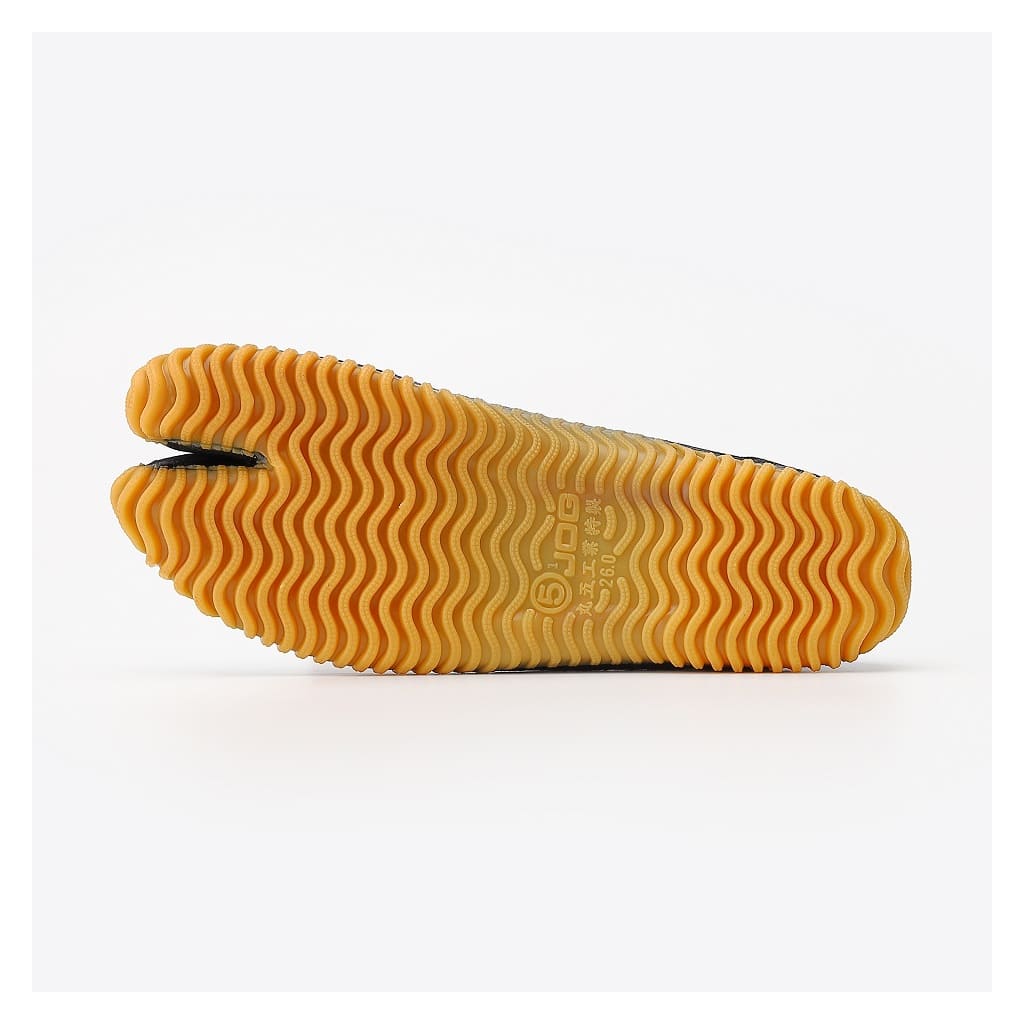There are various types of the costume in Japanese festivals. They are worn by taiko players, too. Let's learn the name, the meaning and the history!
[Clothing]
1. Happi & Hanten (Coat & Jacket)
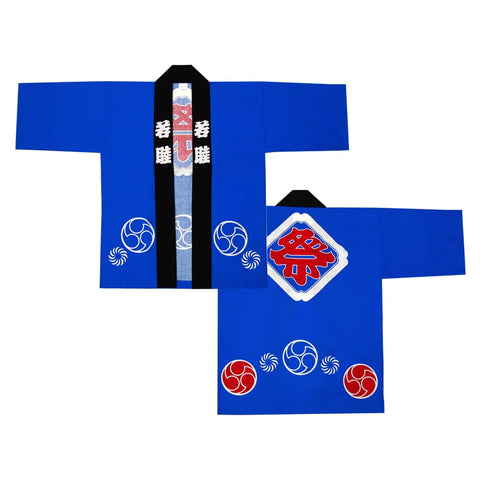
Happi coat is known as popular costume for taiko performance and festival. Generally, people in same group wear same happi coat with same color and pattern to unite together. Happi and hanten are traditional Japanese coat. Technically, "happi" and "hanten" refer to different clothing. Nowadays, we don't really distinguish between them when we say Japanese festival coat ("matsuri happi" or "matsuri hanten"). Some says "happi", others say "hanten". "Shirushi Banten" is the official name for Japanese festival coat that has group name and family emblem printed or sewn on the collars and back. But, most people just call it the abbreviation word like "happi" or "hanten". It's said that it appeared in Edo period (*exact year is unknown). They became popular among common people when they are banned to wear "haori (another Japanese jacket often worn by samurai warrior)". It's been often worn by common people, firefighter, and craftsmen. Nowadays, it's often worn in festival and some business purpose like Japanese inn, sake (Japanese alcohol) brewery and sales promotion event by company. Sometimes, hanten jacket is remade with a cotton into a jacket with cold protection. On the other hand, happi coat for matsuri (Japanese festival) usually doesn't have a liner and festival participants wear it while carrying "mikoshi (portable shrine)" and "dashi (float as known as "yama", "hoko", and "yatai")". Happi for matsuri is often worn over a "haragake" (apron as known as "muneate" and "donburi") and some types of Japanese shirts.
View Happi for Sale
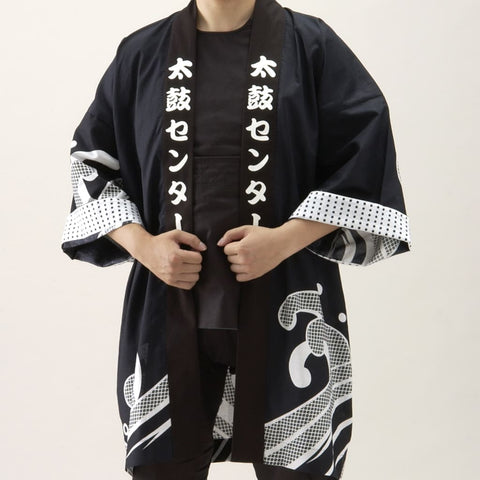
2. Haragake (Apron)
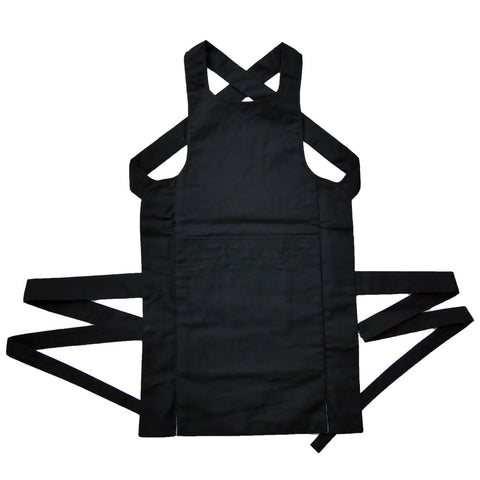
Worker like craftsman and rickshaw man wore "haragake" apron under "happi" coat and "hanten" jacket. It's worn like apron with straps on the back. "Hara" means belly in Japanese and "gake" means putting something around. It's put around belly and chest in order to prevent body from cold and stain. It's said that it already exists as of the late Edo period. It has a pocket on the back or front to put coins into it. It became a typical taiko player's costume effected by 50s Japanese film, Muhoumatsu no Issho (The Rickshaw Man). It's also called "donburi" and "muneate".
View Haragake for Sale

3. Momohiki (Pants)
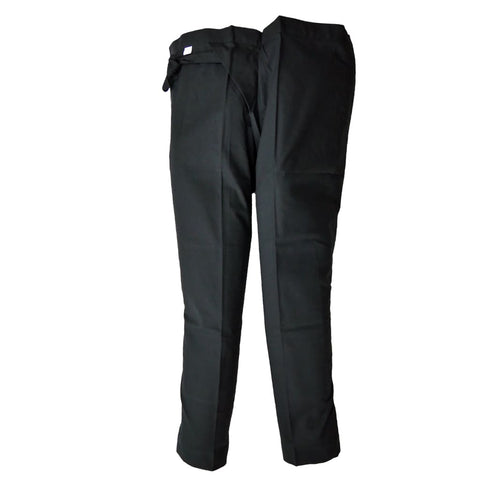
"Momohiki" is a Japanese style work pants. Craftsman and steeplejack wear it with "happi" coat and "haragake" apron. There were loose type and tight type but tight type has been popular among people after late Edo period. It's said that the name of "momohiki" came from an old word "momohabaki". "Momo" means thigh in Japanese. In the old era, kyahan (ankle belt) is called "habaki" and "habaki" for "momo (thigh)" is called "momohabaki". It's said that a word "momohabaki" changed into "momohiki". As well as haragake, It became a typical taiko player's costume effected by 50s Japanese film, Muhoumatsu no Issho (The Rickshaw Man). Short type "momohiki" is called "hantako" or "handako". It was used for travel.
View Momohiki for Sale

4. Koikuchi Shirt
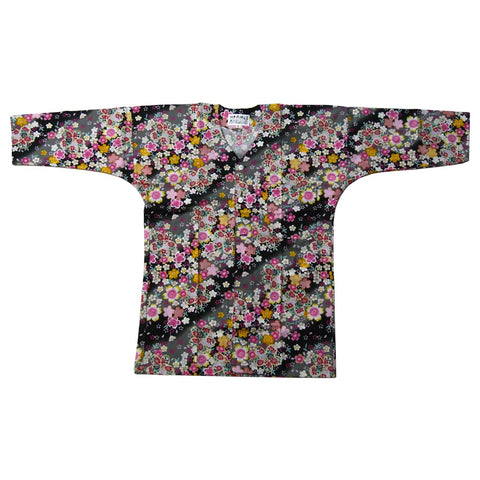
"Koikuchi" shirt is popular festival clothing as well as "haragake" apron and "momohiki" pants. It's named after the shape of the cuffs. The narrow cuffs look like "kuchi" (mouth) of "koi" (carp). This tight shirt with three quarter sleeve often worn under "haragake" apron with "momohiki" pants. Tucking in your shirt makes you look stylish. It's also called "nikujuban" but a word of "nikujuban" also means skin-colored underwear with muscles and tattoo. As well as this "nikujuban" underwear, koikuchi shirt has a variety of loud patterns like flower and imaginary animal.
View Koikuchi Shirts for Sale
5. Yukata (Robe)
"Yukata" is abbreviation of "yukatabira", which was worn to take a bath in the past. The old Japanese bath is a steam bath in temple. People wore "yukatabira" because they mustn't take a bath in the nude for religious reasons. From the early modern era, it became popular to take a bath in the way we do now and people take a bath naked. Then, "yukata" was changed into a kind of the robe worn to absorb sweat after bath. From the middle of Edo era, it's often worn as everyday clothes in summer. It wasn't a outerwear but a lounge wear. Nowadays, it's often worn for summer festival like fireworks display.
View Yukata for Sale
[Footwear]
6. Tabi (Shoes / Boots)
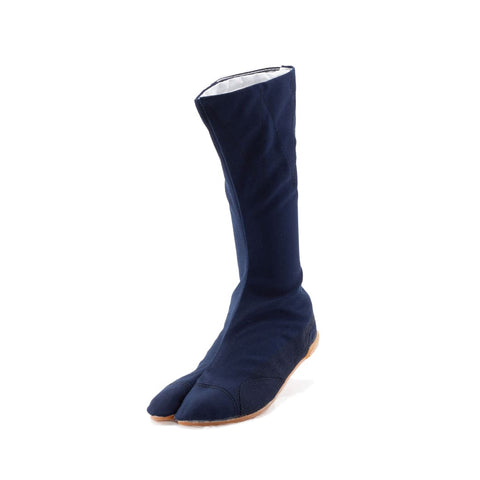
Tabi is known as ninja shoes in the world. In Japan, it's often worn for taiko performance and festivals as well as construction work. "Tabi" is Japanese traditional two-fingers shoes. It's said that the origin of "tabi" is dated back to Nara period and it was developed from an old Japanese footwear "shitozu". Two-fingers tabi appeared to wear with "zouri" shoes in Heian period. Old "tabi" was made of leather and has a long tube shape tighten with long string. In the middle of Edo period, fabric "tabi" appeared and became popular after great fire of Meireki (1657). It is because leather "haori" jacket became popular to prevent it from fire and the prices of leather became high. Short "tabi" is replaced with long "tabi" and "kohaze" hook was developed in this period. White "tabi" was popular among female and navy "tabi" was popular among male. White "tabi" was used as formal wear and navy "tabi" was used for travel in late Edo period. Rubber was imported to Japan in Meiji era and used with sole of "tabi". It is the present "tabi" worn in festival: so-called "jika-tabi" as known as ninja shoes. In the festivals, jika-tabi shoes which have thick rubber sole and air cushion inside are popular because people in the festival often walk the long distance.
View Tabi for Sale

7. Zouri & Setta (Sandals)

"Zouri" is sandals which has a sole with straps called "hanao". It's developed as everyday shoes woven with bamboo peel, rush, and straw. "Setta" is a high-class sandals which has a leather sole on the back of "zouri". There is "setta" with iron and it's considered that walking and making sound with it is smart. "Setta" is more popular among festival people because it's harder to slip than "zouri". Also, people often wear it with tabi (not tabi shoes with thick sole but tabi socks).
View Zouri & Setta for Sale
[Accessories]
8. Hachimaki (Headband)

"Hachimaki" means a cloth wrapped around head. A part of head which is wrapped around with "hachimaki" is called "hachi". "Maki" means wrapping something around. It's been considered that wearing a cloth on the head expresses honor to someone in a dignified manner. In addition, It's said that it has a religious meaning. For example, spiritual power exists by making knots on "hachimaki". Nowadays, it is worn to be pumped up. For example, fishmonger, sushi chef, carpenter, and steeplejack wear it to be pumped up and look cool. Festival participants also wear it around head and carry "mikoshi" portable shrine.
View Hachimaki for Sale

9. Tekkou (Wrist Band)

"Tekkou (Tekou)" is a traditional Japanese wrist band for work and travel, which prevents wrist from damage. It has tube shape and fasten with strings, hooks, and Velcro tape. It is made of fabric but iron wrist band is used for battle. In the festival, people often put it on to protect their wrist from the damage when they carry the "mikoshi" portable shrine and "dashi" float.
View Tekkou for Sale

10. Fundoshi (Underwear)
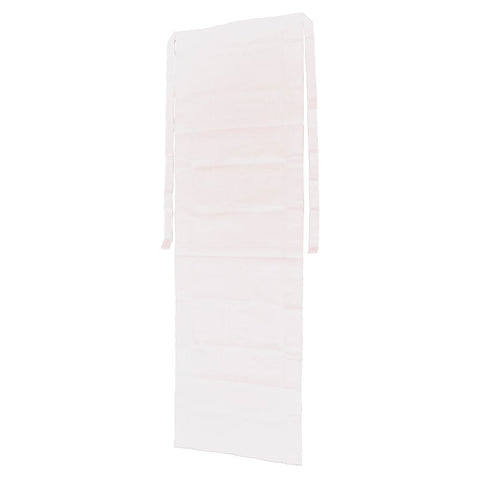
A cloth worn around private parts. Japanese people don't take a bath in the nude by early modern period. They wear fundoshi for bath time. There are some types of fundoshi. The popular type is "rokushaku fundoshi" and "Etchu fundoshi". "Rokushaku fundoshi" is one piece of cloth that has about rokushaku (6 shaku / 2 meters / 79 inches) in length. It's been worn since between Keicho (1596-1615). "Etchu fundoshi" is simple type of the "rokushaku fundoshi". It's easier to wear than "rokushaku fundoshi". It has only a half of "rokushaku fundoshi" in length but has thin strings to wrap around the body. It's been popular among people because of the convenience and saving of material. In the past, it's popular for adult male to wear fundoshi. So, the ceremony was held to celebrate male when he wears a fundoshi for the first time (when he becomes adult from child) as rite of passage in some district of Japan. In some summer festivals, people only wear "fundoshi" underwear without "momohiki" pants. In the "hadaka matsuri" (naked festival), people only wear fundoshi "underwear" in the nude (sometimes, people run around and get in the water in winter).
View Fundoshi for Sale
11. Tenugui (Towel)

"Tenugui" is a traditional Japanese towel made of cotton. It is used in various ways. For example: it's used as a headband, a sweat towel, an advertising material, a celebration gift, a belt, a sash, a string, a substitute of "hanao" strap, and a bandage. Some people just place in on the head like wearing a hat and it's called "oki tenugui". As well as "hachimaki" headband, to wear something like "tenugui" has a spiritual and ritual meaning. It's often used to wipe the face and wrap around the head instead of "hachimaki" headband in Japanese festival. Also, the "tenugui" towel which has the image of the festival is sold as a souvenir.
View Tenugui for Sale
12. Kasa (Hat)

It has various name for "kasa" hat depends on the material (e.g. sugegasa / takegasa / igasa / higasa) and manufacturing method (e.g. nuigasa / amigasa / kumigasa / osaegasa / harigasa / nurigasa). It's considered that it's been used from long time ago because cray images with "kasa" hat were excavated from ancient tomb. It enables people to escape from daily life and change them into someone by concealing one's self. It's a sacred symbol as well as decoration based on "Furyu" an old virtue of Japan still now. In the Japanese dance festival, dancers often wear it.
View Kasa for Sale
13. Omen (Mask)

"Omen" mask is put on the face to play the role of someone and gods in some festivals and folk performing arts. The most popular character is "Okame" and "Hyottoko". "Okame" is female character with charming smile and ugly face. It has rounded face, flat nose, droopy eyelid, large forehead, and high cheekbones. It's also called "otafuku" and "ofuku" as a lucky face. It's used for "kagura" dance and "shishimai" lion dance as a character of crown as well as "hyottoko". "Hyottoko" is a funny male face puckered up his mouth. A word "hyottoko" is derived from the "hiotoko" (to translate directly, it means fire man). His mouth represents the mouth to breathe fire with a bamboo blowpipe. It often appears with "okame" as one of the crown characters in many folk performing arts.
View Omen for Sale
14. Ougi (Fan)
"Ougi" is a traditional Japanese folding fan and one of the ceremonial tools. It's said that it's invented based on wooden tablets called "mokkan" in Nara period. It's used for traditional dance like "gosechi no mai" and "shirabyoshi". It's one of the important tools for traditional folk performing arts in Japan. Sometimes, it's been used for a subject of worship, a tool for game, and a gift. In addition, it's also used to encourage and lead people. For example, in the "gion matsuri" festival in Kyoto, one of the three major festivals in Kyoto, two people on the "hoko" float encourage people and send them signals to move with "ougi" fan.
View Ougi for Sale
Related Articles
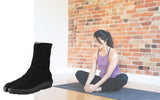 |
Tabi is one of the essential items for Matsuri, Japanese festival. See also this article.
|
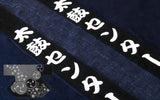 |
Are you interested in custom name item? See also this article.
|
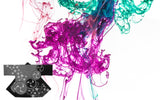 |
Are you interested in traditional Japanese costume and pattern? See also this article.
|
😚Thank you for reading this to the end. Please feel free to ask any questions or leave any comments😉























